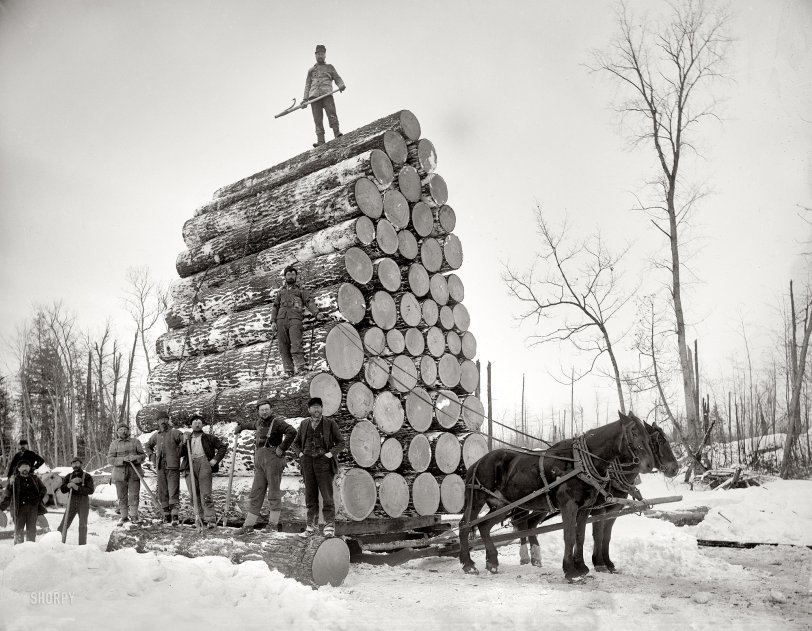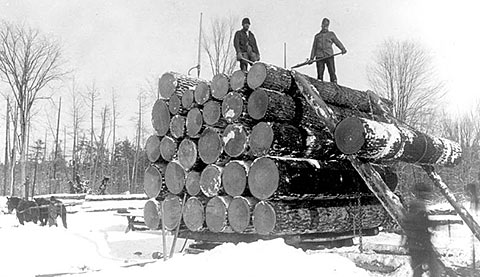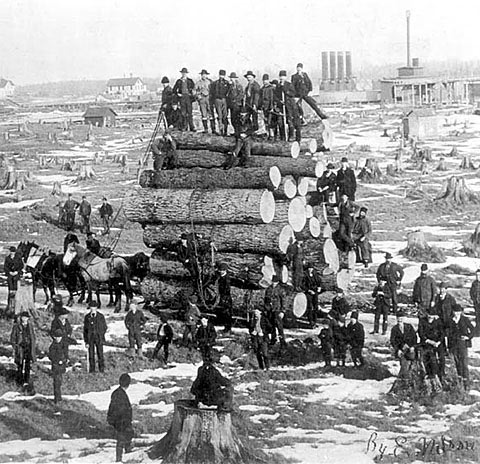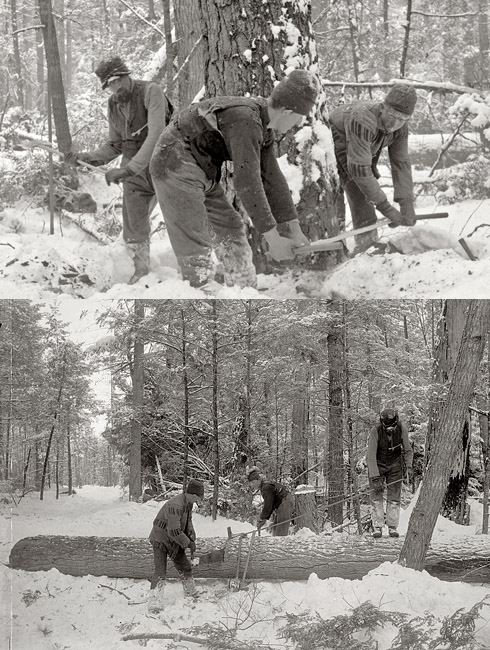


Framed or unframed, desk size to sofa size, printed by us in Arizona and Alabama since 2007. Explore now.
Shorpy is funded by you. Patreon contributors get an ad-free experience.
Learn more.

- Lofty addition
- In 1912
- Keenan Building
- Six years old
- Taken from the P.J. McArdle Roadway?
- It stood only 47 years
- Three track mind
- Incline to the right
- Reach for the sky, 1912 style
- No clean sweep
- Same Job Title, Same Face
- Sadly Lost
- Beautiful ...
- Where you get your kicks
- Aim High
- Pueblo Revival sisters
- Pueblo Neoclassicism
- Milk Man
- Regional dialect.
- Spielberg's inspiration
- Great Photo
- Loaf Story
- Do you still have the Rakes category?
- Could almost be a scene from the 1957 movie 'Hell Drivers'
- The Wages of Fear.
- Conspicuous by their absence
- Got Milk?
- All that aluminum
- No lefties
- Smoke 'em if you've got 'em
Print Emporium
A Big Load: 1890s

Michigan circa 1890s. "Logging a big load." Continuing our Michigan travelog. 8x10 inch dry plate glass negative, Detroit Publishing Company. View full size.
Very cool
I own my family hunting land and it is located in the northern section of the lower peninsula of Michigan. I think this photo is amazing! All Michigan antique photos mean something to me because my family first settled in MI in 1883 (from Oklahoma on horse carriage)
1893 World's Fair Load
This load of white pine was cut on the Nestor Estate near Ewen, Michigan, in Ontonagon County in the Upper Peninsula. It was a world's record load of more than 36,000 board-feet of lumber. The two horses did indeed pull the load approximately a quarter of a mile. It was then loaded onto railcars, along with the sled, and sent to Chicago. The load was reloaded as part of the Michigan Lumber exhibit at the 1893 Columbia Exposition.
-- Hartwick Pines Logging Museum
Shorpy U Rides Again!
Once again, I learn more here than I did from living a few years in WA (logging territory) or from even more years in college!
Love the bit about the sealer...
Thanks, guys and gals!
Lumber sealer
A lumber sealer was the fellow who would mark the ends of the lumber with the "seal" of the company who was doing the logging. Remember, this was when logs were driven to the mill down river, the same river that every other logging company used. Marking or "sealing" was a way of identifying your logs from those of other companies at the mill, it's simular to branding cattle.
Total respect
After a week of felling and logging up 16 large oaks with the help of two Sthil chainsaws and a powerful quad and trailer I have nothing but respect for those loggers of the past. THEY had it tough!
The Forest Today
There is still a large piece of virgin forest left in Michigan's U.P., it is called the Porcupine Mountain Wilderness State Park. The park sits along the shore of Lake Superior and is about 70,000 acres. This forest holds the largest stand of unharvested old growth forest east of the Mississippi River. Hike into the interior trails and experience "what it was like" before the upper Midwest was logged. The white pine and hemlock trees are huge, the air is cool and pure, and the silence of the forest is deafening!
Down to the River
The horses did not pull the sled to the mill. Trees were cut in the winter only and the horses pulled the sled on a pre-iced trail to a river.
The logs were put into the river in the spring and floated to a sawmill. The lumberjacks made a water corral out of some of the logs by chaining them together end to end. The bulk of the logs were put inside the corral.
Steam tugboats pulled the log corrals out into the great lakes and to the sawmills on the main inland rivers. The Tugboats waited in an area where the logs would appear just like a taxi waits for a rider.
This was a seasonal business for the lumberjacks. Winter and spring only.
Lumber Sealer
My great-grandfather, Albert Schuitema, was a lumber sealer in the early 1900's. Maybe he worked in the vicinity of these pictures. Can anyone tell me what a lumber sealer did?
Pulling Power
Two impressive draft horses there.
Wow
Can you imagine what the forests looked like with all the trees that size?
A book on the era
The book "White Pine Days on the Tahquamenon" is a good read on the Michigan logging days.
"Life in a Logging Camp"
There's an interesting illustrated account of white pine logging in Michigan in the June 1893 issue of Scribner's magazine.
It describes a load of logs "18 feet long, 15 feet wide, and 33 feet 3 inches from the top to the roadbed, weighing over 100 tons ... hauled by a single team" over the specially prepared ice covered roads, and says it "will be placed on the grounds of the Columbian Exposition as one of the wonders of the world."
Double Duty
From the photo below it appears that the horses not only had to pull the sled, but they had to help load it too.
Timber Sleds
Here are a couple photos I used in our project about Michigan White Pine Lumbering in the mid 1800's.


Logging in Upper Michigan
The sleds were pulled on ice roads made by spraying the trails with water. The drivers had to be especially careful going down a grade as the load could overrun the horses. If they had an uphill grade they would add a couple helper horses. Another problem was crossing lakes, if the sled fell through the ice it could pull the horses in. These sleds were a big reason why logging was done in the winter in upper Michigan.
It's a living
Aren't you glad you're not a horse?
Maybe the Run is Downhill?
But surely even these brawny experts didn't saw the logs so neatly by hand, so there must be a steam-driven saw and crane nearby.
[The trees were felled and sectioned by hand. - Dave]

Special Shoes
The horses were generally shod with special "clawed" shoes--sort of studded tires of the day. This gave them extra grip in the ice and snow. Also, it would be easier to drag this over the ice (once it was moving)than over dirt roads.
I am a native Oregonian and remember seeing trees like this going through the small towns of my childhood on the back log log trucks.
Puzzled
How the heck did they stack those logs that high?
How the heck do just two horses pull that load?
Regardless, pretty darned impressive.
Incredible
This picture blows my mind. On the one hand, my first inclination is to call it a gag photo. But there it is -- before the days of Photoshop. On the other hand I am left to wonder: How can two horses pull such an enormous load -- on sled runners no less, in snow-covered dirt? All the lumberjacks present suggest we are at the forest, not the mill. How long is the horse-pull to the mill? How were the logs piled so high? I take it there was a steam derrick somewhere abouts. etc. etc. People want to know, Dave.
2 HP
I'm surprised that kind of load can be pulled by only two horses. Hope they don't have to pull it uphill.
Hardly toothpicks
Hope that load didn't become firewood. Can't tell the species from the bark, but that's marvelous timber -- straight, free of limbs (and, thereby, knots and/or crotch wood) -- and some of the logs must be approaching 3 feet across. I see lots of furniture there.
Can't resist
Those lumberjacks sure have a lot of wood.
























On Shorpy:
Today’s Top 5